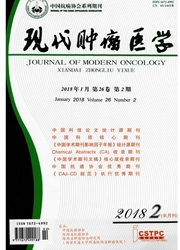

 中文摘要:
中文摘要:
乏氧发生在乳腺癌和其他实体肿瘤中,是由于肿瘤细胞过度增殖超过了其血管的生长速度。乏氧导致由乏氧诱导因子-1α(hypoxia-induciblefactor-1α,HIF-1α)调节的适应性反应,即肿瘤恶化并导致肿瘤细胞对治疗的抗拒。HIF-1α及其下游目标被认为是乏氧标志物。乏氧标志物是重要的预后因子,其测定可预测治疗结果,指导医生针对病人选择最优化治疗方案,达到提高临床疗效和预后的目的。
 英文摘要:
英文摘要:
Hypoxia occurs in breast cancer due to the tumor outgrowing the existing vasculature. Hypoxia leads to an adaptive response, orchestrated by HIF-1α (hypoxia- inducible factor- 1α), that is crucial for tumor progres- sion and therapy resistance responsible for poor patient outcome. Downstream targets of HIF - 1α and itself HIF -1α were considered as hypoxia markers. The hypoxia signature is a significant prognostic factor. The identification of mo- lecular biomarkers with the potential to predict treatment outcome is essential for selecting patients to receive the most beneficial therapy and to improve the clinical efficacy and prognosis.
 同期刊论文项目
同期刊论文项目
 同项目期刊论文
同项目期刊论文
 Identification of novel low molecular weight serum peptidome biomarkers for non-small cell lung canc
Identification of novel low molecular weight serum peptidome biomarkers for non-small cell lung canc 期刊信息
期刊信息
